Rural Families on Relief - Research Monograph XVII - 1938
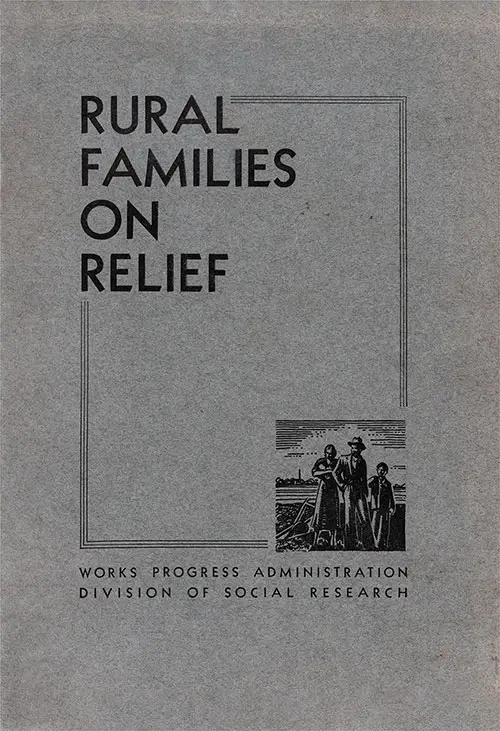
Front Cover, Rural Families on Relief, Works Progress Administration, Division of Social Research, Research Monograph XVII, Washington, DC: United States Government Printing Office, 1938. GGA Image ID # 152ca6c06a
Letter of Transmittal, 27 December 1938
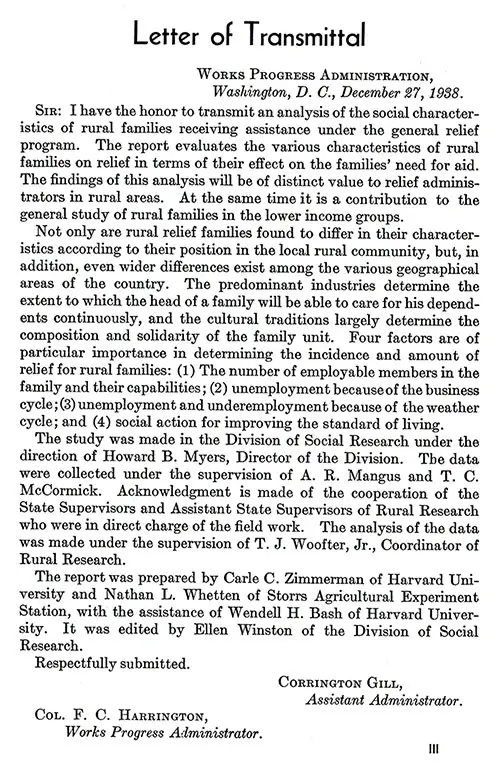
Letter of Transmittal, Corrington Gill and Col. F. C. Harrington of the Works Progress Administration, 27 December 1938. Rural Families on Relief, Works Progress Administration, Division of Social Research, Research Monograph XVII, Washington, DC: United States Government Printing Office, 1938. GGA Image ID # 152caf457a
Letter of Transmittal
Works Progress Administration, Washington, D. C., December 27,1938.
Sir: I have the honor to transmit an analysis of the social characteristics of rural families receiving assistance under the general relief program.
The report evaluates the various characteristics of rural families on relief in terms of their effect on the families' need for aid. The findings of this analysis will be of distinct value to relief administrators in rural areas. At the same time it is a contribution to the general study of rural families in the lower income groups.
Not only are rural relief families found to differ in their characteristics according to their position in the local rural community, but, in addition, even wider differences exist among the various geographical areas of the country.
The predominant industries determine the extent to which the head of a family will be able to care for his dependents continuously, and the cultural traditions largely determine the composition and solidarity of the family unit.
Four factors are of particular importance in determining the incidence and amount of relief for rural families:
- The number of employable members in the family and their capabilities;
- Unemployment because of the business cycle;
- Unemployment and underemployment because of the weather cycle; and
- Social action for improving the standard of living.
The study was made in the Division of Social Research under the direction of Howard B. Myers, Director of the Division. The data were collected under the supervision of A. R. Mangus and T. C. McCormick. Acknowledgment is made of the cooperation of the State Supervisors and Assistant State Supervisors of Rural Research who were in direct charge of the field work. The analysis of the data was made under the supervision of T. J. Woofter, Jr., Coordinator of Rural Research.
The report was prepared by Carlo C. Zimmerman of Harvard University and Nathan L. Whetten of Storrs Agricultural Experiment Station, with the assistance of Wendell H. Bash of Harvard University. It was edited by Ellen Winston of the Division of Social Research.
Respectfully submitted.
Corrington Gill, Assistant Administrator
Col. F. C. Harrington, Works Progress Administrator.
Summary
Rural Families in the United States were subjected to a number of unusual forces during the period 1930-1935 which resulted in severe economic distress in all sections. Some regions suffered directly from only one force or received the diffuse effects of several. In other regions the full brunt of various forces focused on the area and resulted in the almost complete collapse of normal economic and social activities.
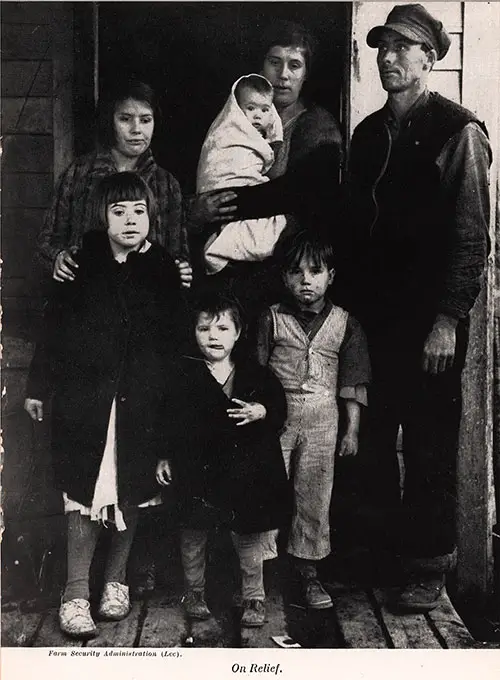
Rural Family on Relief. Photograph by Farm Security Administration (Lee). Rural Families on Relief, Works Progress Administration, Division of Social Research, Research Monograph XVII, Washington, DC: United States Government Printing Office, 1938. GGA Image ID # 152cd9ec1f
While rural distress was caused in considerable part by long-range factors, the effects of the business depression were nevertheless of great importance in the rural relief situation. The drop in the price of farm commodities, because of cyclical fluctuations in the money market, was only one factor in this situation as it affected the farmer and the village dweller.
Included also were price movements resulting from the weather and from crop conditions in foreign countries and the long-time trend in agricultural production and exportation. Thus, all of the agricultural price movements resulted in a decline in prices and sales. This included both the drop in value and quantity of exported goods and the change in the urban market with the depression.
Another force bearing on the rural population and helping to determine relief needs, which can also be identified with the business depression, was the change in nonagricultural work opportunities which accompanied the decline in industry and commerce.
This affected primarily the large numbers of part-time farmers who live in densely settled and relatively urbanized areas. These families were forced to a more complete dependence on the soil and to a more self-sufficient type of farm economy.
Partly connected with the business depression and partly dependent upon a long-time trend has been the decline in the utilization of natural resources. Activity in isolated coal and iron mining areas has decreased or stopped entirely, and the lumber industry has been sharply curtailed. These are typical examples of industries which give employment to rural families either on a part-time or full-time basis.
In some areas the depression coincided approximately with the exhaustion of natural resources so that the shutdown has been permanent rather than temporary. For the most part rural families suffering under the pressure of these forces are located in mountain and wooded areas.
A factor which was not connected with the business depression was the drought. Short-time cyclical movements of rainfall and dry weather have not been unusual on the plains of the great West, but in 1934 and 1936 there were droughts which have been unequalled for both extensity and severity during this generation.
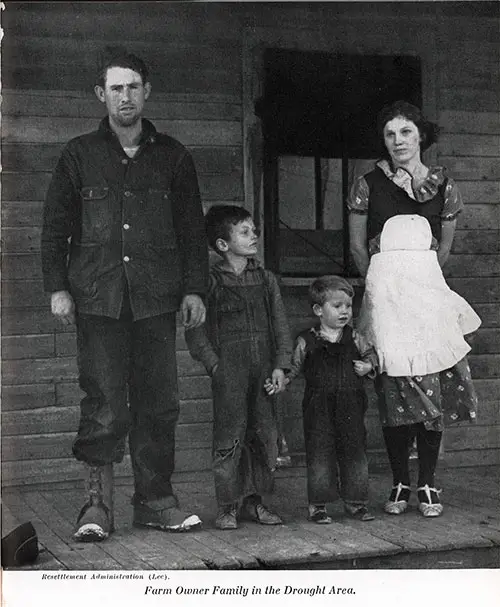
Farm Owner Family in the Drought Area. Photograph by Resettlement Administration (Lee). Rural Families on Relief, Works Progress Administration, Division of Social Research, Research Monograph XVII, Washington, DC: United States Government Printing Office, 1938. GGA Image ID # 152d3bdec3
The most extreme effects of the drought were found in a belt running north and south through the two Wheat Areas and bordering both the Com Belt and Western Cotton Areas, but minor effects of the drought wore found in almost every section of the country.
TYPES OF FARM FAMILIES
Aside from their regional incidence, the forces leading to the need for assistance were found to affect rural families in different ways and different degrees according to the type of farming in which they were engaged. Commercial farmers may be accurately described as small-scale entrepreneurs.
All of their efforts are concentrated on the production of cash crops, generally only one, and usually they grow comparatively little for home use. They live under relatively the same type of money economy as city people, und their prosperity is determined by the price of these goods in the market.
It is also significant that for most of the products included under this type of production the price is largely determined by the surplus which is exported. Since they are goods of relatively inelastic demand and subject to wide fluctuations in supply, such products at times undergo violent fluctuations in price in accordance with weather and economic conditions.
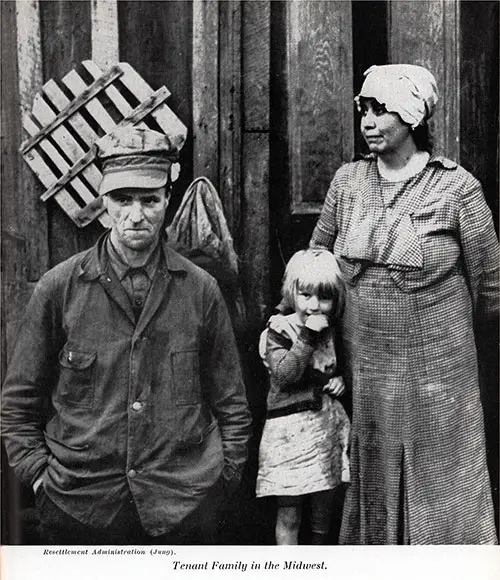
Tenant Family in the Midwest. Photograph by Resettlement Administration (Jung). Rural Families on Relief, Works Progress Administration, Division of Social Research, Research Monograph XVII, Washington, DC: United States Government Printing Office, 1938. GGA Image ID # 152db20388
Consequently, the business depression and the decline in the exportation of foreign products have been the most important factors in every area in the need for relief of commercial farmers. One governmental action which has ameliorated conditions for these farmers has been the agricultural adjustment, program. As a result relief needs have not been as extensive for these farmers as they otherwise would have been.
A second category of farm families may be called noncommercial. It consists largely of those families which combine part-time farming for homo consumption with part-time industrial or commercial work and those which lead a relatively self-sufficing life in the more isolated areas.
For these families the most important influence has been the decline in industry in the isolated areas together with the depletion of natural resources. This includes also the decline in employment in and around cities. These families are influenced to a certain extent, however, by the decline in tho agricultural market since they sell their surplus for cash. These families are helped relatively little by agricultural price-raising.
Cutting across both the commercial and noncommercial groups, a third category of the agricultural population may be called the chronically poverty-stricken. This includes chiefly the farm laborers in all areas and the sharecroppers and tenants of the Cotton Areas. These agricultural groups work for commercial farmers and seldom produce much food for homo consumption.
They are directly affected by the prosperity of the farmers who hire them so that their prosperity and depression are concurrent with those of commercial producers. Moreover, it is safe to say that in the current situation the troubles of commercial farmers have boon passed on to these groups and accentuated in the process.
ANALYSIS OF RURAL RELIEF FAMILIES BY AREA
Although the diversity of occupations and the different types of families within occupations have been repeatedly pointed out, there is still a tendency to think of the rural population as a homogeneous unit.
Since rural was defined for purposes of this study as including the open country and villages of less than 2,600 inhabitants, it is easy to see that nearly all classes and all occupations were included in one way or another.
The rural relief families not only differed in their characteristics according to their position in the local rural community, but also even wider differences existed among the various geographical areas of the country. Major differences in the average family on relief in June 1935 were found, for example, between the Eastern Cotton and Spring Wheat Areas.
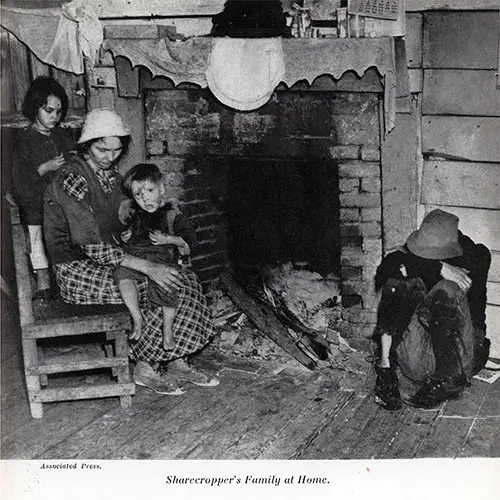
Sharecropper's Family at Home. Photograph by the Associated Press. Rural Families on Relief, Works Progress Administration, Division of Social Research, Research Monograph XVII, Washington, DC: United States Government Printing Office, 1938. GGA Image ID # 152dc87b5a
In addition it was found that, when classified on the basis of type-of-farming area, relatively homogeneous groups in the rural population were set up, even if all the occupations were included. Consequently, the average family in different sections of the country was studied on the basis of a regional analysis, resulting in a better understanding of the peculiar problems in each section.
In the Eastern Cotton Area more of the relief families were engaged in agriculture than the average for the country as a whole, but the proportion was still less than 50 percent. However, because of its comparatively slight urbanization, agriculture and family solidarity still set the prevailing tone.
The relative multiplicity of social classes within agriculture, including owners, tenants, croppers, and laborers, determines a social stratification which is more pronounced than in other agricultural areas.
The relatively small size of the average relief family (3.7 persons) was due partly to the splitting of plantation families and partly to the fact that the median age (43.7 years) of the head of the family was less than for many other areas. Dependent family members were found in about, the same proportions as in the country as a whole, but there were more broken families.
The excessively high mobility within short distances and the low level of formal education are two of the factors leading to an unusually low material standard of living. Considering all factors, however, this area has preserved its social vitality to a greater extent than have many of the wealthier sections.
In the Western Cotton Area more of the relief families (54.3 percent) were customarily engaged in agriculture. The average family was a little larger than in the Eastern Cotton Area (3.8 persons) but was still smaller than the average for the country.
The splitting of plantation families was probably more widely practiced hero than in the older and more traditional East, and here also the heads of families were relatively young (41.7 years of age). Slightly more of these families were normal families consisting of husband and wife or husband, wife, and children than in the Eastern Cotton Area.
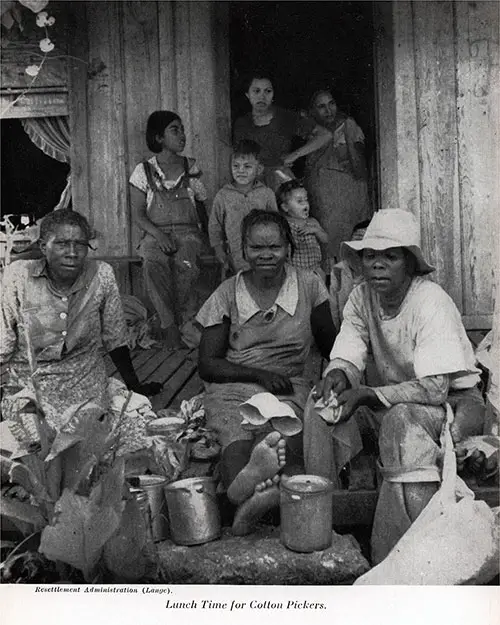
Lunch Time for Cotton Pickers. Photograph by the Resettlement Administration (Lange). Rural Families on Relief, Works Progress Administration, Division of Social Research, Research Monograph XVII, Washington, DC: United States Government Printing Office, 1938. GGA Image ID # 152dd588b1
Although they had more dependents, this did not result from an unduly higher birth rate. In many ways, material standards are slightly higher in the Western Cotton Area, but the improvement in material levels has meant a regression or at least no advance in the stability and vitality of social relations.
In the Appalachian-Ozarks is found the best example of self-sufficing farm family living. Four out of ten of the heads of rural relief families were customarily employed in agriculture. Here the average family was the largest (4.3 persons) of any area with the exception of the Spring Wheat Area.
The fertility of the rural relief population was the highest of any of the areas surveyed. Although families in this area frequently have a meager existence, a minimum living is assured to them as long as they remain on the land. The chief function of this area continues to be the production of new workers for the cities.
The Corn Belt is a relatively prosperous and highly commercialized area. Here corn is produced either for sale directly or for the feeding of livestock. Commercial production is dominant, and agriculture is on a relatively large scale. The average head of a rural relief family was 43.5 years of age, and 4 out of 10 heads were engaged in agriculture.
The tendency toward a small family system is evident; and, although there was a high proportion of normal families, the fertility rate was below the average. In this area farm families ns a whole have achieved a level of living seldom paralleled in agricultural history, but the social system does not give great evidence of stability, and the farm family is not maintaining its strength and vitality.
The Hay and Dairy Area cuts through some of the most highly urbanized sections of the country. It forms a belt from the Atlantic seaboard to the fertile lands of Wisconsin which supplies dairy and other products demanded by the highly industrialized and commercialized culture of that section of the country.
Only a small proportion of agriculturalists (28.9 percent) was found among the relief families in this area. The median family was about the same size ns the average for the country, but the head was about 2 years older on the average. Although 76.0 percent of the rural relief families were normal families, the birth rate was lower than for all areas surveyed.
Since most workers gain their living in nonagricultural occupations and since most of the farmers are directly dependent upon the prosperity of the urban market for the sale of their products, the problems of this area are essentially the same as, or are ultimately tied up with, those of the contiguous cities.
The Lake States Cut-Over Area is made up of isolated farming sections and mining communities. Only 26.0 percent of the heads of rural relief families wore agriculturalists, and the problems are in many ways different from those in the neighboring Hay and Dairy Area.
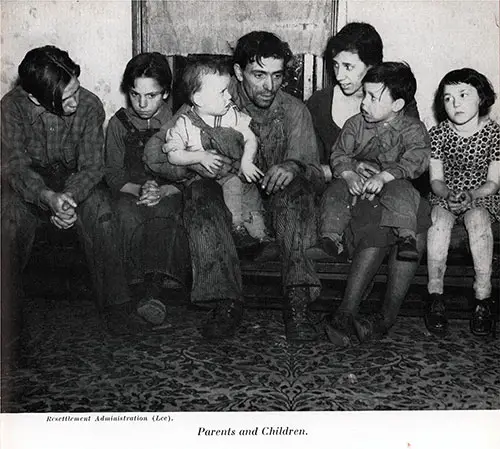
Parents and Children. Photograph by the Resettlement Administration (Lee). Rural Families on Relief, Works Progress Administration, Division of Social Research, Research Monograph XVII, Washington, DC: United States Government Printing Office, 1938. GGA Image ID # 152e271ab0
Its recent settlement, its relative cultural heterogeneity, its isolation, and the depletion of its natural resources are all factors which help to determine its extremely high relief rate, its meager standard of living, and its as yet unstable culture.
Although there are differences between the two Wheat Areas, in contrast with other agricultural areas they present many similarities. A higher proportion of the families is engaged in agriculture than in other areas, with the exception of the Western Cotton Area, and most of this agriculture is of the extensive, commercial type.
Like the Corn Belt, the Wheat Areas have had periods of great material prosperity; educational standards are advanced; and material comforts are highly valued. However, the comparatively recent settlement and development of the Wheat Areas, the ethnic heterogeneity, the high rates of social mobility, and the wide fluctuations in climatic conditions are all factors leading to a social instability which markedly affected relief rates. '
In the extensiveness of its agricultural production, the Ranching Area is but a step removed from the Wheat Areas. However, mining and lumbering occupations raise the proportion of nonagricultural workers and help account for the large proportion of nonfamily groups in the rural relief population.
In many respects this area presents problems which are different from those in other areas, but the probability is that these differences in family statistics are influenced particularly by factors associated with an area of new settlement.
The New England Area represents a further intensification of the factors found in the Hay and Dairy Area. Urbanization has proceeded farther, and the rural culture is even more highly commercialized and industrialized.
Only one out of eight of the rural relief families in this area in June 1935 was engaged in agriculture, and the proportion of nonagricultural families in the relief population was higher than in any other area surveyed. This is due both to the large number of local rural industries and to the presence of large numbers of city workers living in the surrounding countryside.
OCCUPATIONAL ORIGIN OF THE HEADS OF RURAL RELIEF FAMILIES
Agricultural occupations accounted for about the same proportion of the heads of rural relief families in dune 1935 as did the nonagricultural occupations, 40.6 percent as compared with 41.2 percent.
Considering that relief represented only one of four public measures to assist agriculture, it is disheartening that so many farm families had to have this form of assistance. The proportion of agriculturalists among the heads of rural relief families varied from more than two out of three in the Spring Wheat Area to one out of eight in New England.
Among the agriculturalists there were two and one-half times as many farm operators as farm laborer families on relief. This is not surprising since there are considerably more than twice as many farm operators as hired farm laborers in the United States.
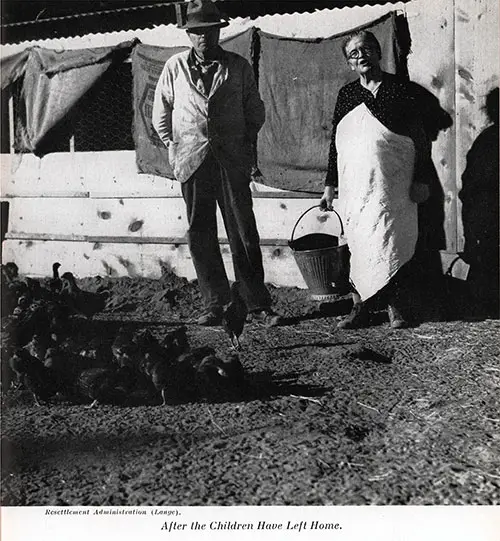
After the Children Have Left Home. Photograph by the Resettlement Administration (Lange). Rural Families on Relief, Works Progress Administration, Division of Social Research, Research Monograph XVII, Washington, DC: United States Government Printing Office, 1938. GGA Image ID # 152e46a3b9
Within the farm operator group, however, tenant families constituted a greater proportion of the relief cases than did farm owner families although the country as a whole contains about throe farm owners for every two tenants.
Unskilled laborers accounted for by far the largest proportion of heads of nonagricultural families. In New England there were also a large number of relief families whoso heads were skilled and semiskilled workers.
Families whose heads were nonworkers accounted for 15.6 percent of all relief cases, reflecting the tendency for relief rolls to include a large number of families that for various reasons contain no breadwinner. In 2.5 percent of the cases the head of the family had no usual occupation.
PERSONAL CHARACTERISTICS OF THE HEADS OF RURAL RELIEF FAMILIES
The average head of a rural relief family was in the prime of life, the early forties. Village heads, on the whole, were about 2 years older than those in the open country. The heads of families in New England had the highest average age (46.6 years), while the lowest average age was found in the Winter Wheat Area (39.0 years).
The median age of heads of agricultural families on relief was about the same as that of heads of nonagricultural families. Farm owners, however, but the highest average age of any occupational group on relief (46.5 years).
On the other hand, farm laborers were the youngest group, averaging only 36.4 years. Among the nonagricultural people the skilled laborers with an average ago of 43.7 years had the highest overage of any subgroup.
Negro family heads on relief were much older than white heads on the average. In the Eastern Cotton Area the difference was 4.9 years and in the Western Cotton Area 7.5 years.
The western areas of extensive, commercialized agriculture had the smallest proportions of rural relief families with female heads while the southern areas, including the Eastern and Western Cotton and the Appalachian-Ozark Areas, had the highest proportions of such families.
An exception to this rule was found in the Ranching Area which ranked with the South in the proportion of families with female heads. Significant differences also existed between village and open country residents in that almost half again as many village heads of rural relief families were women as was the case among open country heads.
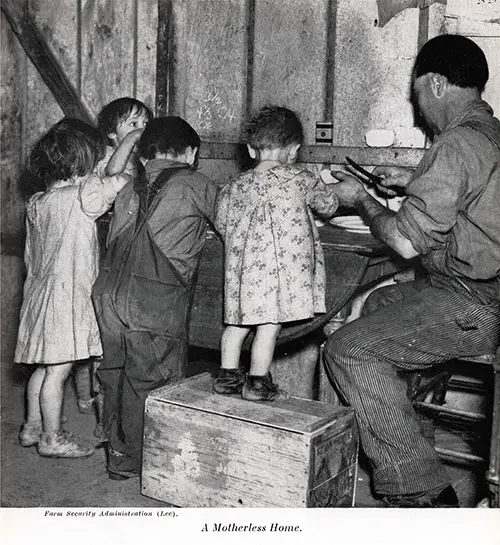
A Motherless Home. Photograph by the Farm Security Administration (Lee). Rural Families on Relief, Works Progress Administration, Division of Social Research, Research Monograph XVII, Washington, DC: United States Government Printing Office, 1938. GGA Image ID # 152e4bf8c5
Most of the male heads of relief families were married, while most of the female heads were either unmarried or had had their homes broken by divorce, separation, or death. For all areas the highest proportion of female heads married was 15.7 percent for the age group 45-64 years, while the lowest proportion was 0.6 percent for those aged 65 years and over.
In contrast, the highest proportion married among the male heads was 90.9 percent in the age group 25-34 years, and the lowest was 61.5 percent in the ago group 65 years and over. The proportion of family heads that was married was greater in the open country than in the villages, while the proportion of widowed, divorced, or separated heads tended to be greater in the villages.
Differences in marital condition among the areas were consistent with differences in social and economic backgrounds. The greater industrialization of New England and the North has led to a greater participation in industry by women, and consequently the emancipation of women has reached its most advanced stages in these regions.
Accompanying this emancipation is a rapidly rising divorce rate and a general disintegration of former social rules which have regulated the distribution of rights and duties of the sexes.
SIZE AND COMPOSITION OF RURAL RELIEF FAMILIES
The problem of the size and composition of relief families is important to relief programs from a number of points of view, but principally because largo families, or those with numerous dependents and few gainfully employed or employable, may need relief more frequently and in larger amounts than smaller families or those with relatively more productive units.
The median size of the rural relief family in June 1935 was 3.9 members. The open country families were larger than those in the villages. Averages, however, do not give an adequate picture of the situation with respect to size of family. Of all the rural households receiving relief in June 1935, 9.9 percent were one-person households.
This was a 2 percent greater proportion of one-person households than was found for the whole rural United States in the 1930 Census (7.7 percent). Since severe economic depressions usually tend to increase social solidarity, at least for a time, it would seem from these data that the proportion of one-person households receiving relief was very much greater than could be expected from a normal sample of the rural population.
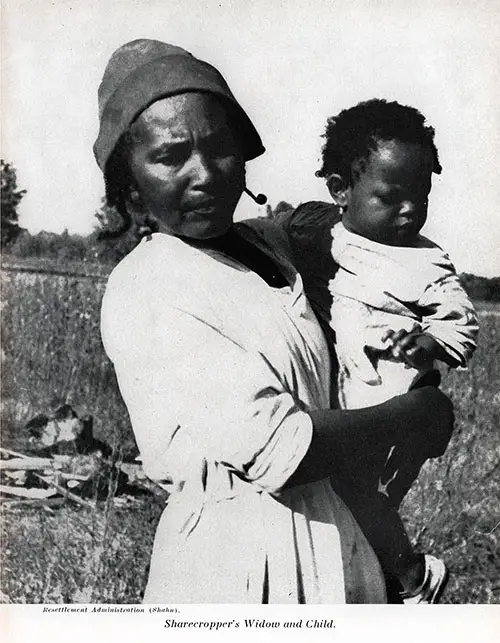
Sharecropper's Widow and Child. Photograph by the Resettlement Administration (Shahn). Rural Families on Relief, Works Progress Administration, Division of Social Research, Research Monograph XVII, Washington, DC: United States Government Printing Office, 1938. GGA Image ID # 152e90f9fd
Further comparisons with census data suggest that a larger proportion of rural relief families consisted of six persons or more, whereas a larger proportion of families in the general population consisted of two or three members. Families with four or five members were found in about equal proportions among both relief families and families in the general population.
Rural relief families had relatively more young members (children under 16 years of age) than are found in the general rural population, and they contained a smaller proportion of adults of working age.
DEPENDENT AGE GROUPS
Four out of five of the rural relief families contained persons in the dependent age groups, i. e., persons under 16 years of age or 65 years of age and over. Three out of five relief families had children under 16 years of age but no one over 64 years; one-eighth of the families had aged individuals 65 years of age and over but no children under 16; while one out of twenty families contained both children and aged persons. These proportions varied somewhat among the agricultural areas of the country and were related to the type of economy and the "age" of the area.
In general a large number of dependents in a family may be an indication of a prolific population, where a high birth rate results in large families, or it may indicate a high degree of family solidarity. Again there is the possibility, as shown in the Cotton Areas, that there may be a splitting of families so as to place aged persons on relief and to leave the younger employable people to fend for themselves without the responsibility for other individuals.
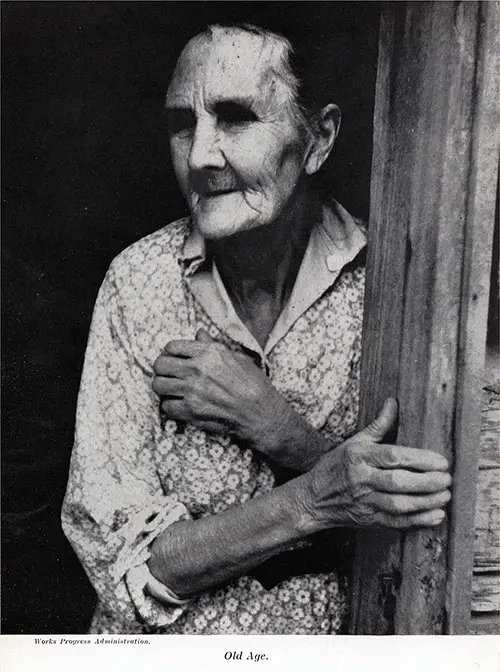
Old Age -- An Elderly Woman. Photograph by the Works Progress Administration. Rural Families on Relief, Works Progress Administration, Division of Social Research, Research Monograph XVII, Washington, DC: United States Government Printing Office, 1938. GGA Image ID # 152e9d25bd
All of these factors may operate to increase the number of old or young dependents on relief. The question of dependency and relief is, however, related principally to the basic economic and cultural factors in any particular region.
The predominant industries and occupations determine the extent to which the head of a family will be able to care for his dependents continuously, and the cultural traditions to a large extent determine the internal solidarity and cohesiveness of the family unit.
Background factors of an economic, sociological, or even medical nature, when viewed in their full complexity, are agents which determine the number of dependents on relief. Families in the South, including the Appalachian-Ozark Area, for example, are likely to be large as a result of high birth rates; they tend to cling together in a large cohesive aggregate.
Loss of economic support, or the injury or death of the chief provider, quickly forces the whole aggregation on relief. Therefore, it is easy to understand why the proportion of families with no persons in the dependent age groups should be smallest in the South, where rural cultural traditions are strong, and greatest in the North, where the strong Yankee traditions are now nearly submerged by the newer mores of an industrialized and urbanized society.
FAMILY STRUCTURAL TYPES
For purposes of analysis family units were divided into three main types—normal families, broken families, and nonfamily types. In the normal group were found 72.5 percent of all rural relief families, while 10.9 percent were broken families and 16.6 percent were nonfamily types.
The great majority of the normal families consisted of husband and wife or of parents and children alone, while about one out of nine also had relatives or friends present. Normal families were relatively more frequent in the open country than in the villages, and a larger proportion in the open country consisted of husband, wife, and children, as compared with husband and wife only in the villages.
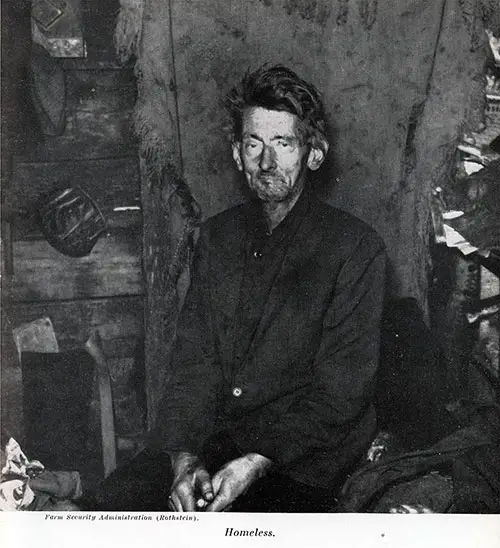
Homeless Man. Photograph from the Farm Security Administration (Rothstein). Rural Families on Relief, Works Progress Administration, Division of Social Research, Research Monograph XVII, Washington, DC: United States Government Printing Office, 1938. GGA Image ID # 152ea26ace
Likewise there were more broken families in the villages than in the open country, and broken families with female heads especially tended to congregate in the villages. Normal families were relatively more prevalent among the agricultural (82.2 percent) than among the nonagricultural (77.4 percent) families.
Broken families occurred most frequently in the southern areas. Nonfamily types were most evident among the Negroes of the South and in the industrial and urban areas of the North and East.
FERTILITY OF RURAL RELIEF FAMILIES
The relationship between fertility and relief is difficult to measure. A comparison of the relief data with the 1930 Census data was made for identical counties, and certain relationships wore noted concerning the number of children under 5 years of age per 1,000 women 20 to 44 years of age in the population.
The comparison is subject to qualification on several scores, however. One difficulty is the fact that there was a difference of 5 years between the census figures and the relief figures, and the depression of the early thirties had far-reaching effects on marriage and birth rates.
Another was that relief practices in certain areas, particularly in the Western Cotton Area, resulted in the splitting of tenant and cropper families and resulted in the placing on relief of aged or unemployable members while the younger and more able members were kept under the care of the landlord.
This naturally would tend to affect the size of the relief family. From such data as were available, however, it appears that for the country as a whole the fertility ratio for the relief families was considerably higher than that for the general population.
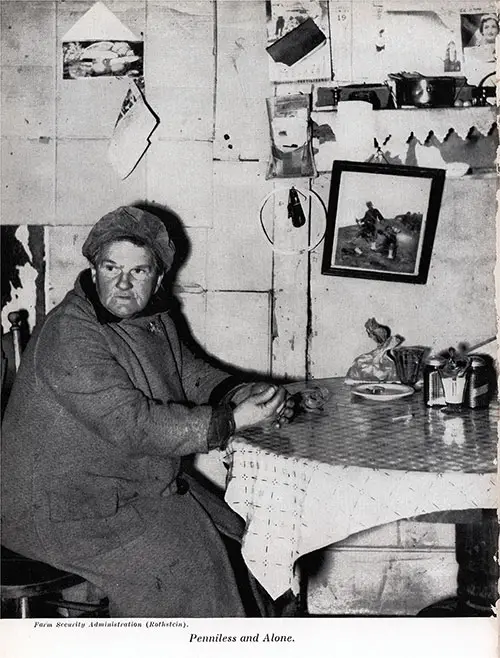
Penniless and Alone. Photograph by Farm Security Administration (Rothstein). Rural Families on Relief, Works Progress Administration, Division of Social Research, Research Monograph XVII, Washington, DC: United States Government Printing Office, 1938. GGA Image ID # 152eac3b27
This is to be expected since relief families, for the most part, come from the lower social and economic strata where the birth rates are higher than those in the higher strata. Furthermore, since population traits are well grounded in the mores, relief families with more children may continue, at least for a time, to have children while still on relief.
The relationship between fertility and relief, however, was by no means uniform. In some areas fertility was much higher among relief families than among census families, particularly in the Appalachian- Ozark and Ranching Areas.
In other areas the differences were smaller, while in the Eastern Cotton Area the number of children under 5 years of age per 1,000 women aged 20 to 44 years was actually slightly smaller for the relief families than for all families in 1930.
EMPLOYABILITY, EMPLOYMENT, AND AMOUNT OF RELIEF
Employability and employment are directly related to relief and are vital factors in family status in either prosperity or depression. The employability composition of a family sets the outside limits for its employment success, and many families are greatly handicapped by the lack of any capable member between the ages of 16 and 64 years.
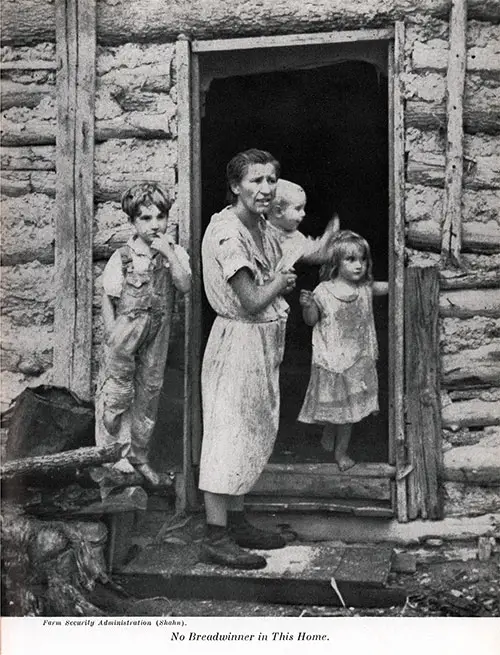
No Breadwinner in This Home. Photograph by Farm Security Administration (Shahn). Rural Families on Relief, Works Progress Administration, Division of Social Research, Research Monograph XVII, Washington, DC: United States Government Printing Office, 1938. GGA Image ID # 152f3cf616
The plight of many rural relief families can be shown by the fact that one-eighth of them had no employable worker and an additional 7.8 percent of these families had female workers only. These two types of unemployability taken together were relatively most important in the two Cotton Areas. Unemployability was especially high among the Negroes of the South and relatively lower among the whites.
During times of depression work in agriculture is relatively more stable than in nonagricultural, although the past unusual period in agricultural production forced a large number of normally self-supporting agricultural families on relief. However, only 29.2 percent of the gainful workers who had usually been employed in agriculture were unemployed at the time of the survey in contrast with 72.1 percent of the nonagricultural workers.
The small proportion of unemployed in agriculture, however, was partly due to the fact that farm operators were arbitrarily defined as employed if they were still on their farms, even if they had no cash income. For the groups that were actually employed within these broad classes, much more occupational shifting had taken place among the nonagricultural occupations.
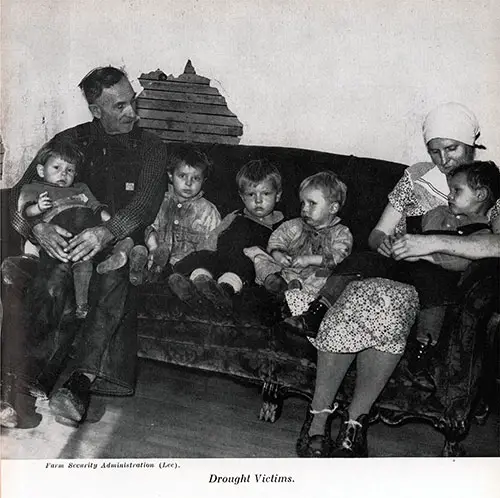
Drought Victims. Photograph by the Farm Security Administration (Lee). Rural Families on Relief, Works Progress Administration, Division of Social Research, Research Monograph XVII, Washington, DC: United States Government Printing Office, 1938. GGA Image ID # 152ff6b4ce
Only 1 percent of the former workers in agriculture had shifted into nonagricultural jobs, but almost 11 percent of the nonagricultural workers were employed in agriculture at the time of survey.
This difference was also shown by the fact that 95.8 percent of all the workers in agriculture who were employed were engaged in their usual occupations as contrasted with 55.7 percent of the workers in nonagricultural. In part this reflects a widespread movement back to the farm during the depression, and in part it also represents a reversed current of occupational mobility, which caused a general shifting down the scale for workers at all levels.
When rural relief families were analyzed according to continuity of their relief histories, certain trends were observable. Of all cases on relief in June 1935, 74.3 percent had received assistance continuously since February.
Another 14.2 percent of the cases had been reopened between March and June, and only 11.5 percent were new cases. Slightly more new cases appeared in the villages than in the open country.
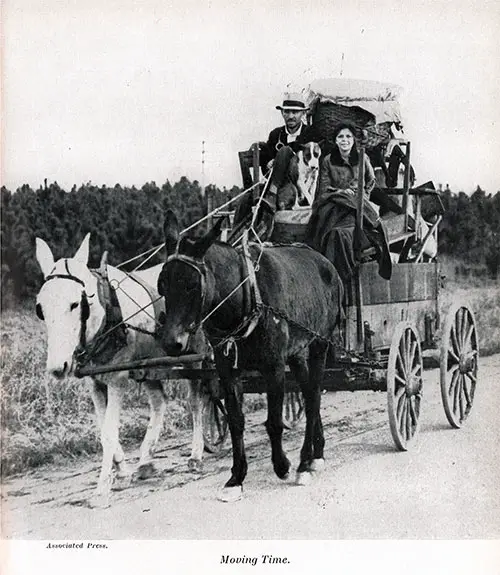
Moving Time. Photograph by the Associated Press. Rural Families on Relief, Works Progress Administration, Division of Social Research, Research Monograph XVII, Washington, DC: United States Government Printing Office, 1938. GGA Image ID # 15301c050f
Continuous relief histories were found most frequently among groups of a generally low economic level or among groups especially affected during the depression period by unusual circumstances. The Negroes in the South are an example of the first type, and the farmers in the drought area are an example of the second type.
The average amount of relief per family was influenced mainly by these same factors, low economic levels or unusual conditions of stress. Also of importance in the determination of amount of relief were comparative price levels and costs of living. Lowest amounts of relief were found in the three southern areas, particularly among the Negroes, and the highest amounts were spent in the industrialized areas of the North and East.
Indeed, the cost of relief per family in the Eastern and Western Cotton Areas was not more than one-third the cost in New England. Four factors were most important in determining the incidence and amount of relief for rural families: (1) The number of employable in the family and their capabilities; (2) unemployment because of the business cycle ; (3) unemployment and underemployment because of the weather cycle; and (4) social action for improving the standard of living.
MOBILITY OF RURAL RELIEF FAMILIES
Only crude measure« of the mobility of rural relief families were available. For the most part the families were divided into three groups as follows: lifelong resident», referring to those families whose head was born in the county in which he was living at the time of the survey; predepression migrants, referring to those families whose head moved to the county at any time prior to 1930; and depression migrants, including those families whose head moved to the county some time during the period 1930 to Juno 1935.
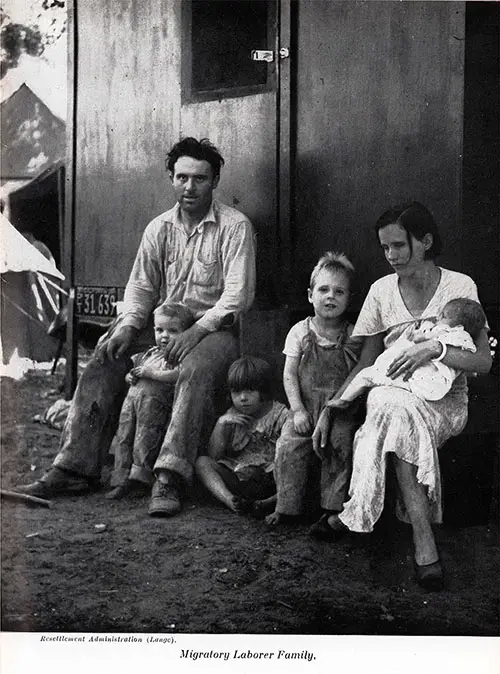
Migratory Laborer Family. Photograph by the Resettlement Administration (Lange). Rural Families on Relief, Works Progress Administration, Division of Social Research, Research Monograph XVII, Washington, DC: United States Government Printing Office, 1938. GGA Image ID # 1530632a27
Of the heads of rural families on relief in Juno 1935,40.5 percent were lifelong residents of the county; 45.6 percent had moved to the county before the depression; and the remaining 13.9 percent were depression migrants. As might be expected, smaller proportions of the heads of rural relief families were lifelong residents in the more recently set tied areas than in the areas of older settlement.
The proportion of lifelong residents was 14.4 percent in the Winter Wheat Area, 17.8 percent in the Lake States Cut-Over Area, 22.4 percent in the Ranching Area, and 28.0 percent in the Spring Wheat Area. All of these are areas of comparatively recent settlement. Portions of the two Wheat Areas and of the Lake States Cut-Over Area were settled as recently as the World War.
Proportionately more lifelong residents were found in the South and in other sections of older settlement. Migration during the depression was characterized by two main types. The first was migration because of the drought.
This was most noticeable in the Wheat Areas and the Western Cotton Area, resulting in a shifting of population within those areas and also a movement to the villages and to the States in the far West. The second form of depression migration was the back-to-the-farm movement from the depression-stricken cities. This was important in the self-sufficing areas of the Northeast. It was also of great importance in the mountain areas of the South.
Agriculture is an occupation which encourages stability as contrasted with nonagricultural. Within agriculture farm operators were more stable than farm laborers, but among the nonagricultural occupations unskilled laborers were the most stable group.
More nonagricultural than agricultural workers had moved during the depression. The depression meant a move to the village for farm operators and a move to the country for nonagricultural workers while many farm laborers simply moved to another location in the open country.
EDUCATION OF RURAL RELIEF FAMILIES
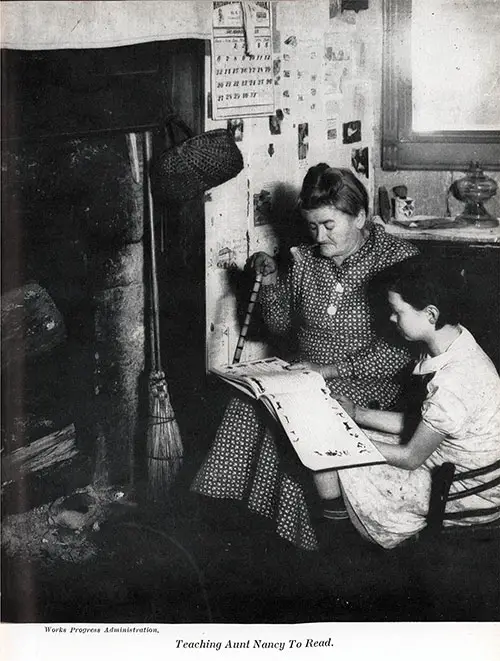
Teaching Aunt Nancy to Read. Photograph by the Works Progress Administration. Rural Families on Relief, Works Progress Administration, Division of Social Research, Research Monograph XVII, Washington, DC: United States Government Printing Office, 1938. GGA Image ID # 1530aff6cb
Heads of rural relief families were found to be on a comparatively low educational level since less than 4 percent were high school graduates and only about 35 percent had completed as much as a grammar school education.
Wide differences appeared among the various areas, however, as well as between village and open country residents, between agricultural and nonagricultural workers, and between whites and Negroes. In general, the educational level was higher in the more industrialized and urbanized areas than it was in the more agricultural areas.
Similarly, within each area the agricultural workers had a lower educational level than the nonagricultural workers. In every area a larger proportion of the heads of village families had completed a grammar school education than had the heads of families living in the open country; for all areas combined the difference reached approximately 11 percent.
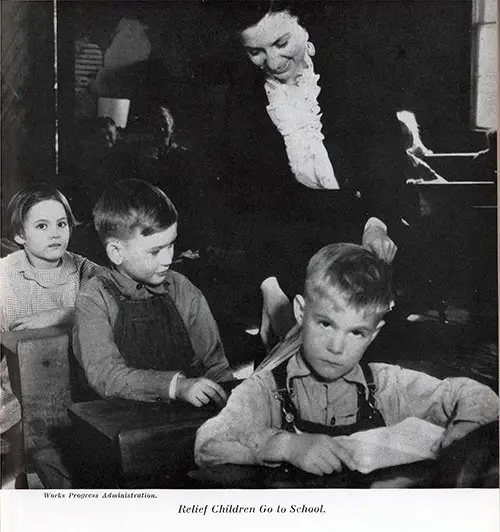
Relief Children Go to School. Photograph by the Works Progress Administration. Rural Families on Relief, Works Progress Administration, Division of Social Research, Research Monograph XVII, Washington, DC: United States Government Printing Office, 1938. GGA Image ID # 1530dd3ed9
In the South Negroes were on a lower educational level than whites. The median school grade completed by heads of white relief families in the Eastern Cotton Area was 5.9 years, while for heads of Negro relief families it was only 2.9 years. The median school grade completed for all heads of rural relief families in all areas was 6.4 years.
The contrast between the education of heads and of other family members, particularly of youth and children, reflects the fact that educational levels have been rising during the past generation. This was most noticeable in areas of low standards where the requirements have been raised rather rapidly and are beginning to approximate the standards of the country as a whole.
Carle C. Zimmerman and Nathan L. Whetten, Rural Families on Relief: Transmittal Letter and Summary, Works Progress Administration, Division of Social Research, Research Monograph XVII, Washington, DC: United States Government Printing Office, 1938

